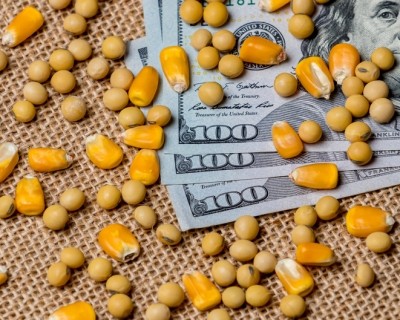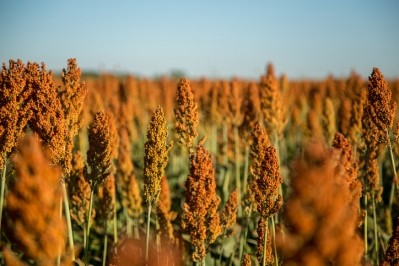Feed grain producers, users see volatile start to year

The Colorado-based agricultural financial company released details regarding rural economics and production last week in a quarterly review.
Feed grain producers have started harvest while tariffs covering several agricultural products remain in place and trade negotiations with China continue, said analysts with the CoBank Knowledge Exchange. However, the pause in tariff increases and the potential for high-level meetings between the US and China have allowed for increased sales of US soybeans.
Recent sales have boosted commodity markets, but uncertainty regarding the outcomes of talks “continues to hang over the long-term view of the US’s export competitiveness into China” the report authors said.
However, the trade deal signed between the US and Japan did provide some positive momentum, said Tanner Ehmke, manager of CoBank’s Knowledge Exchange and report co-author.
“The agreement with Japan is a positive as it would reduce or eliminate tariffs on $7.2bn of US agricultural commodities and bolster US competitiveness, especially with Japan being the leading export destination for US wheat and corn,” he told FeedNavigator. “But, it doesn’t remove the market uncertainty that’s predominantly a result of the ongoing situation with China.”
Grain market considerations
Wet spring weather delayed planting for primary feed crops like corn and soybeans, the authors said. The lagging pace generated high volatility in grain markets.
“Because of the lateness in maturity of this year’s spring-planted crops, volatility’s going to be much higher until the crop is in the bin and the total bushels are known,” added Ehmke.
Old-crop corn supplies saw increased pricing from end-users, including livestock and poultry feeders, seeking to secure feed based on the anticipation that the fall harvest could be small, the authors said. However, prices have since dropped to levels more consistent with those set prior to planting.
Old-crop inventories are also tending to move east from Illinois and Iowa as grain merchandisers work to offset fears of potential supply shortages, they said. But, shortages in select regions could continue to prompt volatility in local basis through the winter.
The current estimation is that the corn crop will be 13.8bn bushels with a yield of 168.2 bushels an acre, they said. The production is down from the 14.4bn bushels generated last year.
“After USDA announced a much higher than expected crop estimate in August, corn futures fell 17% before reaching contract lows,” they said. However, there continue to be questions regarding the USDA’s estimate.
“Nearly all states are behind in crop maturity, but the most concerning delays are in the eastern Corn Belt states of Illinois, Indiana, Michigan, Ohio, and Wisconsin, and the western Corn Belt states of North Dakota and South Dakota where maturity lags 20-30 percentage points behind average,” the authors said in the report. “Harvested acreage is also expected to be down as more acres are chopped for silage instead of harvested for grain.”
However, grain handlers in the Western Plains have been anticipating large harvests this fall, which has prompted preparation to store corn and sorghum both in bunkers and ground piles, they said. In some areas, wheat and sorghum are set to compete with corn for use in feed as cash wheat prices have dropped below cash corn prices.
Soybean factors
Soybean prices improved in recent months following concerns regarding the planting and development of the US crop and hope that the market to China could be reopening, the authors said. But, limited trade progress and large inventories “continue to weigh on the market.”
“The trade war continues to haunt US soybean farmers with the US now carrying record soybean supplies into fall harvest,” they said. “Exports continue to lag, particularly to China, as the US and China remain embattled in an ongoing trade war.”
Exports to some regions, including the EU, have improved, but have not been able to offset the drop in sales to China, the authors said. Competition for Chinese market space has been increasing and Argentina recently gained the ability to export soybean meal to China.
“As the US-China trade war rages on, Brazilian and Argentinian farmers are looking to capitalize on new Chinese business,” they said. “South American farmers will soon plant the 2020 soybean crop and their soybean acreage is widely expected to expand.”
The forecast production for the upcoming soybean crop anticipates a drop to 3.6bn bushels from the 4.5bn bushels raised last year, they said.
The delay in planting and crop development has prompted fears of early frosts, said Ehmke.
“The corn and soybean crops in the eastern Corn Belt and northern regions are most at risk of an early frost cutting crop yields short,” he said. “Globally, though, grain stocks remain ample – and are widely expected to dull any significant rallies.”
Livestock production, exports
US animal protein markets have had a volatile year thus far with changes in feed costs, disruption to trade, political issues and capacity disruptions, the authors said.
The cool, wet spring helped boost livestock weights and increased supply, which may mean that supply growth in 2019 will match the 2.5% generated last year, they said.
Beef producers saw a drop in feed prices, but the loss of a production plant in August reduced cattle harvesting capacity by 6%. Much of that capacity has since been absorbed by other facilities.
Exports were slow at the start of the year, but are expected to improve, they added.
The outbreak of African Swine Fever (ASF) in Europe and Asia provides a “potential bright spot” for US swine producers as the spread of the disease created an upswing in pork prices, especially in China, the report authors said. “With trade negotiations between the US and China still ongoing, market participants are struggling to forecast how or when the US will benefit from increased pork shipments to China long term,” they added.
Pork exports started slowly with declines to export markets including Mexico, South Korea and Japan, they said.
“While it may seem that the decline in pork exports with Mexico, Japan and Korea are connected; shipments to Mexico were affected by retaliatory tariffs from Mexico in response to our tariffs on their steel and aluminum, shipments to Japan were hurt by lower tariffs from neighboring countries as part of the Comprehensive and Progressive Agreement for Trans-Pacific Partnership, and shipments to South Korea were hurt by elevated cold storage inventories that the country built during the 2018 fears of African Swine Fever,” said Will Sawyer, report co-author and animal protein economist with CoBank’s Knowledge Exchange.
Going forward it is expected that the resolution of some of the trade challenges could allow for continued improvement in exports through the end of the year, the authors added.
Poultry production has not witnessed the same supply growth as beef and pork, the authors said. It is anticipated that growth in 2019 will reach 2%, slightly below that seen last year.
Pricing has remained higher than previous years and the US has an improved space for export as competitors focus on the Chinese market, they said. Export volume for poultry has been flat, but the pace is expected to increase throughout the end of the year.













